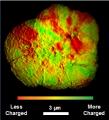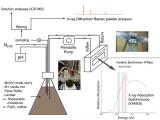Giant magnetic resistance (GMR) is a quantum mechanical phenomenon observed in thin structures made of alternating metal layers having differing ferromagnetic properties. When the adjacent ferromagnetic layers of these multilayer materials are magnetized in parallel, there is little electrical resistance, but when magnetization is antiparallel, there is higher resistance. This property allows these materials to be used as magnetic sensors, and thin-film magnetic multilayers have been a popular topic of research. A team of researchers has tested the atomic properties of a variety of nickel and gadolinium (Ni/Gd/Ni) thin-film multilayers.
Approximately 1,700 scientists visit SSRL annually to conduct experiments in broad disciplines including life sciences, materials, environmental science, and accelerator physics. Science highlights featured here and in our monthly newsletter, Headlines, increase the visibility of user science as well as the important contribution of SSRL in facilitating basic and applied scientific research. Many of these scientific highlights have been included in reports to funding agencies and have been picked up by other media. Users are strongly encouraged to contact us when exciting results are about to be published. We can work with users and the SLAC Office of Communication to develop the story and to communicate user research findings to a much broader audience. Visit SSRL Publications for a list of the hundreds of SSRL-related scientific papers published annually. Contact us to add your most recent publications to this collection.
Many bacteria, including many colonizing our own gut biomes, produce hair-like pili structures on their surfaces. There are various types of pili used for different purposes, like exchanging genetic information (conjugation), movement, and adhesion. A bacterium builds pilus through oligomerization of protein subunits. A group of scientists have determined the structure of a new type of pilus, which they named the type V pilus.
Most portable electronic devices depend on lithium ion batteries for energy storage. The current capabilities of lithium ion batteries are insufficient for the requirements of emerging and growing industries, like electric cars and renewable energy storage. These industries require batteries that are longer-lived, smaller, lighter, and cheaper. One way to improve lithium ion batteries is to increase the charging cutoff voltage, which increases the energy that can be stored in the battery, but it leads to shortened battery life, called capacity fade. A team of scientists has discovered a new mechanism for capacity fade.
Protein enzymes can contain specific sites to bind copper atoms for a variety of purposes. Depending on the environment and role of the enzyme, different amino acid residues are employed to bind Cu(I). Oxygenase enzymes employing Cu(I) often use both methionine (Met) and histidine (His) amino acids, while membrane transport proteins often use Met and not His. The identity and placement of the amino acids coordinating the Cu(I) atoms create different local environments, but it is unclear how this affects the Cu(I) atom to fulfill the role it serves for the enzyme or transporter. A team of scientists has recently developed a new experimental approach to measure the local environmental effects on Cu(I) reactivity.
Zinc oxide (ZnO) is used to coat optoelectronic technology, which includes components that create and/or detect light, x-rays, infrared, or other forms of radiation. When ZnO properly crystallizes, it creates a transparent conducting film. The performance of the film is compromised when there is disruption in nucleation and growth of ZnO. A team of scientists collaborated to study the process of electrodeposition of ZnO into films.
The element manganese can have complex interactions with the environment, depending on the prevailing conditions. Manganese(IV) is a strong oxidant but can also bind to environmental toxins and heavy metals, rendering them less harmful. Both geochemical and microbial processes affect the reactions of manganese(IV) in the environment. A team of researchers were interested in following the complicated reactions and mineral products produced during the reduction of manganese(IV) under different environmental conditions.
Theorized decades ago and currently being developed into useable technology, memristors are passive memory storage units especially useful for nanoelectronics. Memristors could replace the ageing flash memory in the near future. Memristors are usually made of a transition metal oxide layered between two metallic electrodes and are able to change their resistance in a non-volatile way between two states depending on an applied voltage.
Most solar panels use technology that employs a silver-silicon interface. Because silver is expensive and the lead used in the creation of this interface is toxic, researchers are interested searching for other materials that could work instead of these components. A team of scientists are working to understand the process involved in the silver-silicon contact formation so that alternatives that perform the same function can be found.
Current technologies of light emitting diodes (LEDs), photovoltaic systems (PVs), and other optical electronic devices typically use inorganic silicon-based semiconductors. However, organic polymers could provide thinner, lighter and cheaper opto-electronic devices (like OLEDs and OPVs).
The electrocatalytic conversion of carbon dioxide and water into useful chemicals and fuels is a promising way of mitigating greenhouse gas emissions and of providing sources for renewable energy. Part of these processes is the oxidation of water into molecular oxygen, a reaction that requires a catalyst. Previously, heterogeneous catalysts have been used, but adoption of homogeneous catalysts allows more understanding and fine-tuning of the atomic-level processes.













